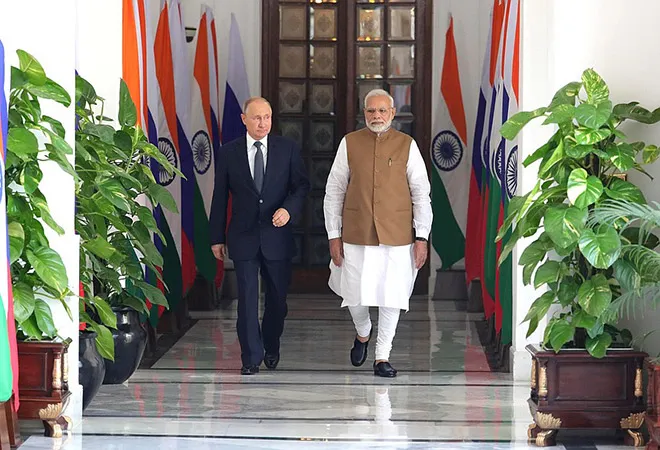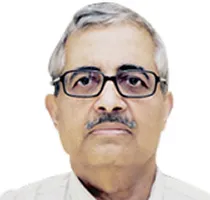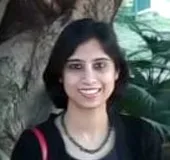
The year 2014 was marked by new developments for both India and Russia: the former saw a new government led by Prime Minister Narendra Modi take charge in May that year, and the latter witnessed deteriorating ties with the West over Crimea and the Ukrainian crisis. By that time, the impression had been created that Indo-Russia ties were stagnating as both countries not only tried to define their own roles in a changing world, but also to assess the importance of their bilateral relationship.
Despite the announcement in 2010 of the “special and privileged strategic partnership,”<1> there were clear signs of a drift in the relationship. The goal of reaching US$20 billion in trade by 2015 was not even close to being achieved (See Figure 7). In contrast, India–US trade was recorded at US$142.1 billion in 2018 and Russia-China trade had reached US$107.06 billion<2> in the same year.
Another indication of the relative stagnation of India-Russia ties was the fact that in 2014, the US emerged as the top arms supplier to India, pushing Russia to second position.<3> Additionally, in 2016, much to the consternation of Russia, India became a major defence partner of the US (2016), it began the 2+2 dialogue (2018), and signed the Logistics Exchange Memorandum of Agreement (LEMOA, 2016) as well as the Communications Compatibility and Security Agreement (COMCASA, 2018). For its part, Russia overturned its decades-old policy and after 2014 supplied China with advanced weapons systems including Sukhoi 35 and the S400 missile defence system. It also engaged with Pakistan, much to the dismay of India, through the sale of Mi-35 helicopters and engines for JF-17 Thunder, and began joint military exercises.
Given that the military-technical ties have formed the bedrock of the bilateral relationship, a decline in the sector was a matter of concern. As analyst Dmitri Trenin has noted, the pattern of the relationship had failed to evolve in the changing global scenario and the ties had not been put on a “qualitatively new level.”<4>
At the same time, however, the potential of the relationship was underscored by important agreements on the construction of 12 nuclear power plants in India over the coming two decades, the “localization of manufacturing” in India for Russian-designed nuclear power plants, and the finalisation in 2014 and 2015 of the supply of crude oil by Rosneft to Essar and cooperation in helicopter engineering. In 2016, crucial inter-government agreements were signed during the annual summit. These agreements concerned the supply of S-400 Triumph Air Defence Missile System, and four frigates<5> (the deals were finalised in 2018), as well as the manufacture of Ka-226T helicopter in India (See Figure 8).
The year 2017 marked 70 years since the establishment of diplomatic relations between India and Russia. Various agreements were signed, though none of them big-ticket, during the annual summit in 2017, including on the construction of third stage of Kudankulam nuclear power plant.<6>
The first ever Tri-Services exercise under the annual INDRA format and India joining Shanghai Cooperation Organisation (SCO) as a full member were positive developments that year. In terms of investment, the two countries had set a target of US$30 billion by 2025; the goal was reached by 2017, and the new target is set at US$50 billion by 2025.<7> There were no significant arms deals signed in 2017.<8> This development came in the backdrop of the cancelled Multi-role Transport Aircraft and India pulling out of the Fifth Generation Fighter Aircraft project that had begun in 2007. <9>,<10>
In May 2018, it was announced that PM Modi will meet Russian President Vladimir Putin for an informal summit at Sochi, the first interaction in such format with the Russian leader. Coming just four months before the October
2018 annual bilateral summit, the Sochi summit was an acknowledgement of the need to address the drift in the relationship. The two leaders issued a joint statement after the October summit that contained concrete developments including the conclusion of the contract for supply of S-400, first meeting of NITI Aayog and Ministry of Economic Development, start of FTA talks between Eurasian Economic Union and India, launch of single window service in Russia for Indian companies, launch of Russia Plus in India to help Russian companies invest in India, holding of the India-Russia Business Summit, setting up of the Far East Agency in Mumbai, signing of the India-Russia Economic Cooperation: The Way Forward (March 2018), and the beginning of LNG supply from Gazprom (contract with GAIL).<11> There have been over 50 ministerial level visits since 2017.
The S-400 deal, despite the threat of it attracting Countering America’s Adversaries through Sanctions Act (CAATSA), was a sign of India’s desire to maintain its strategic autonomy as well as build on its strong defence relationship with Russia. While overall, Russia remained India’s top supplier of defence items between 2014 and 2018, the total exports had fallen by 42 percent from 2009-13.<12> Russia still commands 58 percent of total arms imports by India, followed by Israel and the US at 15 and 12 percent, respectively.<13>
However, divergences over foreign policy priorities are likely to continue in the future. The most prominent of this is the Russian displeasure over the ideation of the “Indo-Pacific,” with Foreign Minister Sergei Lavrov calling it an “artificially imposed construct” being promoted by the US, Australia and Japan, to contain China.<14> The remarks, made in February 2019, came despite the fact that some months earlier in June 2018, PM Modi in his Shangri La speech made it clear that the concept of Indo-Pacific for India is based on “inclusiveness, openness and ASEAN centrality and unity”<15>. The two also have a divergence of opinion over Afghanistan, although intensive discussions have led to certain clarity.
At the same time, there are areas of convergence between India and Russia that can provide a way forward, like the proposal in the 2018 joint statement to “actively promote joint projects in third countries” in areas “where there is a complementarity between them in terms of technology and resources”<16> (India and Russia are involved in the Rooppur nuclear plant project in Bangladesh on a trilateral basis).
Moreover, the proposal of President Putin for a “more extensive Eurasian partnership involving the EAEU and China, India, Pakistan and Iran”<17> should be used by India to strengthen its presence in Eurasia. The main challenge here would be from China’s expansive Belt and Road Initiative (BRI), which Russia has joined; it plans to link the Eurasian Economic Union (EAEU) to the BRI. India’s connectivity plans in the region, in the form of the International North–South Transport Corridor (INSTC), have been languishing. Russia and India could jointly energise the project.
The trade relationship needs active intervention to take advantage of policies like ‘Make in India’. Concrete proposals in the areas already identified by the two countries need to be implemented on a priority basis. These include start-ups, infrastructure, shipbuilding, river-navigation, high-speed railways, space, food processing, and high-technology products (e.g. space technology, aviation, new materials, agriculture, information and communication technologies, medicine, pharmaceuticals, robotics, nanotechnology, supercomputing technologies, artificial intelligence and material sciences).<18>
India can also be of help to Russia in providing workforce in sectors like agriculture and construction without engaging in permanent settlement. Given that the situation is particularly acute in the Russian Far East due to the continued decline of the population (having declined by 24 percent between
1991 and 201560), India can provide a solution to the demographic problem apart from being a partner in investing in energy and other projects in the region. The two also have the chance to cooperate on issues in various multilateral forums such as the United Nations, the BRICS, SCO, G20, and the East Asia Summit. However, even in these cases, diverging foreign policy goals driven by factors beyond the bilateral dimension will continue to pose challenges to the partnership in the coming years, as both countries seek to strengthen their positions at a time of flux in the regional and global order.
This article originally appeared in special report Looking Back looking Ahead.
End Notes
<1> “Joint Statement: Celebrating a Decade of the India- Russian Federation Strategic Partnership and Looking Ahead,” Ministry of External Affairs, 21 December 2010, accessed 5 May 2019.
<2> “Russia’s trade with China surges to more than $107 billion,” Russia Today, 14 January 2019, accessed May 6, 2019.
<3> Rajat Pandit, “US pips Russia as top arms supplier to India,” The Times of India, 13 August 2014, accessed 5 May 2019.
<4> Dmitri Trenin, “From Greater Europe to Greater Asia? The Sino-Russian Entente,” Carnegie Endowment for International Peace, 9 April 2015, accessed 6 May 2019.
<5> “Signing of Military and Defence agreements,” Press Information Bureau, Ministry of Defence, Government of India, 8 August 2017, accessed 5 May 2019.
<6> “List of MOUs/Agreements signed during the 18th India-Russia Annual Summit,” Ministry of External Affairs, Government of India, 2 June 2017, accessed 4 May 2019.
<7> “India attaches ‘highest importance’ to ties with Russia: Sushma Swaraj,” The Economic Times, 14 September 2018, accessed 4 May 2019.
<8> Siemon T. Wezemanetal., “Developments in Arms Transfers, 2017,” in SIPRI Yearbook 2018 (Oxford: Oxford University Press, 2018), 206.
<9> Franz-Stefan Gady, “India-Russia Aircraft Deal Terminated,” The Diplomat, 28 March 2017, accessed May 5, 2019.
<10> PTI, “India tells Russia to go ahead with FGFA project; says it may join at a later stage,” The Economic Times, 13 July 2018, accessed 6 May 2019.
<11> “India-Russia Joint Statement during visit of President of Russia to India,” Press Information Bureau, 5 October 2018, accessed 3 May 2019.
<12> Pieter D. Wezeman, Aude Fleurant, Alexandra Kuimova, Nan Tian And Siemon T. Wezeman, “Trends in International Arms Transfers, 2018,” SIPRI, March 2019, accessed 2 May 2019.
<13> Ibid.
<14> Sergey Lavrov, “Foreign Minister Sergey Lavrov’s Remarks and Answers to Media Questions During The Russia-Vietnam Conference of the Valdai Discussion Club,” Valdai Discussion Club, 26 February 2019, accessed 4 May 2019,
<15> “Prime Minister’s Keynote Address at Shangri La Dialogue,” Ministry of External Affairs, 1 June 2018, accessed 1 July 2019.
<16> “India-Russia Joint Statement during visit of President of Russia to India,” Ministry of External Affairs, 5 October 2018, accessed 1 July 2019.
<17> “Plenary Session of St Petersburg International Economic Forum,” Official Internet Resources of the President of Russia, 17 June 2016, accessed 1 July 2019.
<18> “Saint Petersburg Declaration by the Russian Federation and the Republic of India,” Ministry of External Affairs, 1 June 2017, accessed 4 May 2019.
The views expressed above belong to the author(s). ORF research and analyses now available on Telegram! Click here to access our curated content — blogs, longforms and interviews.




 PREV
PREV



